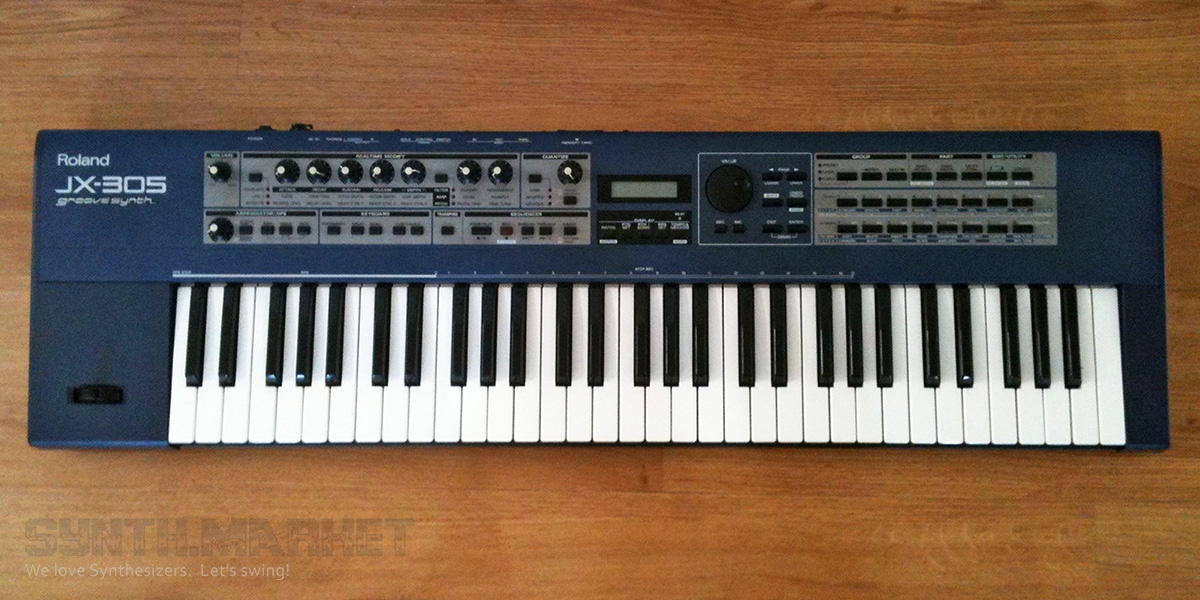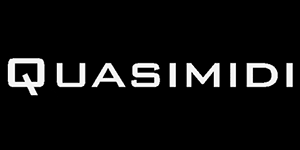The Roland JX-305 represents a significant evolution of Roland's dance-oriented MC-505 Groovebox, repackaged into a traditional keyboard format. This transformation brings the powerful synthesis engine and pattern-based sequencing capabilities of the MC-505 to keyboardists seeking a more conventional playing experience while maintaining the core functionality that made its predecessor so popular in electronic music production.
Design Philosophy and Construction
Roland has taken a pragmatic approach with the JX-305's design, moving away from the MC-505's distinctive silver metal construction and retro styling in favor of a more conventional late-1990s synthesizer aesthetic. The instrument features a sleek dark blue plastic casing with low-profile buttons, pinpoint LEDs, and a clean, modern layout that prioritizes functionality over flashiness.
The control surface incorporates 10 knobs and 56 buttons, along with an alpha dial for parameter adjustment. While it lacks the MC-505's characteristic sliders, faders, and chunky flashing lights, Roland has implemented a three-color labeling system that clearly indicates control functions across different modes. Seven assignable Real-Time Modify knobs provide hands-on control over key parameters, serving as the primary interface for real-time sound manipulation.
Keyboard and Performance Controls
At the heart of the instrument lies a 61-note synth-action keyboard with both velocity and aftertouch sensitivity, providing expressive control over the extensive sound library. Roland has included their traditional combination pitch-bend/modulation controller, along with dedicated front-panel controls for Portamento, Split, and Dual functions, enabling instant keyboard splits and layers.
The instrument significantly expands connectivity options compared to many mid-range keyboards, featuring three footpedal inputs (sustain, volume, and programmable switch) compared to the MC-505's single input. This enhanced control capability makes the JX-305 more suitable for live performance applications.
Sound Generation and Synthesis Architecture
The JX-305 utilizes Roland's proven S&S (Sample and Synthesis) engine derived from the JV family, offering maximum 64-note polyphony across 8 parts with full multitimbral capability. The synthesis architecture allows for sophisticated sound construction using up to four Tones per Patch, though four-Tone patches reduce available polyphony.
Each Tone passes through comprehensive modifying stages including dual LFOs, pitch envelope, filter with envelope, and amplifier with envelope. The system offers 10 different Tone Structures that define how pairs of Tones combine within a Patch, including options for ring modulation and controlled distortion through booster gain effects.
The waveform library has been significantly expanded from the MC-505's 505 samples to over 600 waveforms. This expansion includes the complete MC-505 collection plus additional traditional instrument sounds such as violins, pianos, harpsichords, and ethnic instrument samples, making the JX-305 more versatile as a general-purpose instrument while maintaining its electronic music focus.
Patch Programming and Real-Time Control
Sound editing occurs through the LCD display and a collection of 16 buttons, providing access to comprehensive parameter groups including Wave selection, Pitch modification, Filter configuration, Amplifier settings, and LFO programming. The filter section offers multiple types (low-pass, band-pass, high-pass, and peaking) with full envelope control.
The seven Real-Time Modify knobs provide immediate access to critical parameters. Two knobs can be assigned to control filter cutoff and resonance, tone level and pan position, or portamento time and fine tuning via an adjacent switch. The remaining five knobs, with their associated switch, can edit envelopes, LFO 1, or effects parameters. This system, while not as immediate as dedicated controls, offers substantial real-time control over key sonic parameters.
Factory Sound Library
The JX-305 ships with an impressive collection of 640 factory Patches (compared to the MC-505's 512) and 32 Rhythm Sets. The sound library encompasses the MC-505's electronic-focused patches while adding traditional instrument simulations. Notable additions include authentic Rhodes electric piano sounds, quality harpsichord patches, nylon-string guitar simulations, and atmospheric string ensembles.
User patches can be stored in 250 memory locations, with additional storage available via Smart Media cards when internal memory is exhausted. The instrument maintains 100% compatibility with MC-505 Pattern and sound data, though the reverse compatibility is limited due to the JX-305's expanded waveform set.
Pattern-Based Sequencing
The built-in eight-track sequencer maintains functional parity with the MC-505, offering both real-time and step-time recording with sophisticated quantization options including Roland's groove templates. The sequencer comes preloaded with 768 preset Patterns (expanded from the MC-505's 714) spanning various musical styles from contemporary dance to traditional genres.
Pattern programming supports up to 32 bars per pattern with tempo ranges from 20-240 BPM. Song construction allows chaining up to 50 Patterns, with each step capable of different effects and Part Mixer settings. The sequencer captures movements of most front-panel controls, enabling dynamic automation of parameters during playback.
The Part Mixer functionality, while different from the MC-505's dedicated faders, utilizes the Real-Time Modify knobs through a display-based interface. This system provides similar functionality for adjusting level, pan, effects sends, and transposition across the eight sequencer parts.
Advanced Sequencing Features
The Real-time Phrase Sequencer (RPS) extends the instrument's apparent multitimbrality by allowing up to 16 phrases to play alongside the main eight-part sequence. These phrases, triggered by the keyboard's bottom 16 notes, can be drawn from any Pattern within the instrument, providing powerful tools for live performance enhancement and composition development.
Pattern Set mode enables real-time triggering of up to 16 Patterns assigned to the Patch/Pattern select buttons, making it particularly useful for live performance applications where instant access to different groove patterns is essential.
Arpeggiator Capabilities
The sophisticated arpeggiator offers 43 preset Styles ranging from simple up/down patterns to complex genre-specific accompaniments including House, Tango, Waltz, and ethnic styles like Shamisen. Users can create and store 10 custom arpeggiator patterns.
The arpeggiator system provides extensive customization through different Motifs (defining note order within chords), Beat Patterns (controlling accent location and note length), shuffle rate adjustment, and three-octave range settings. All arpeggiator activity can be recorded into sequencer Patterns for further development.
Effects Processing
Three dedicated effects processors provide comprehensive sound enhancement. The reverb processor offers six algorithms (two rooms, two stages, two halls) with parameters for reverb time, level, and high-frequency damping. The delay processor provides short and long delays with tempo sync capability, feedback, damping, and level controls.
The multi-effects processor offers 24 different algorithms including various modulation effects (chorus, phaser, flanger), dynamics processing (compression, tremolo), distortion (overdrive), and creative effects (Lo-Fi simulation, Noise Generator). Effects can be routed in parallel or several serial configurations for enhanced sonic flexibility.
Connectivity and Integration
Standard connectivity includes stereo audio outputs, full MIDI implementation (In, Out, Thru), and comprehensive MIDI control recording. The instrument can sync to external MIDI clock sources or provide clock to other devices. A Smart Media card slot enables pattern and patch storage expansion.
Power is provided through an external wall-mounted adapter, and the instrument includes a phones output for private monitoring. The pedal inputs support sustain, volume, and programmable functions including tap tempo control.
Technical Specifications
Keyboard
- Keys: 61-note synth-action
- Sensitivity: Velocity and channel aftertouch
- Controllers: Pitch bend/modulation wheel combination
Sound Generation
- Polyphony: Maximum 64 voices
- Multitimbrality: 8 parts + 16 RPS parts (24 total)
- Synthesis: S&S (Sample and Synthesis) engine
- Waveforms: Over 600 samples
- Tone Structure: 10 different combination methods
- Sound Architecture: Up to 4 Tones per Patch
Memory and Storage
- Factory Patches: 640 preset
- User Patches: 256 locations
- Card Storage: 512 patches via Smart Media
- Rhythm Sets: 32 factory, 20 user, 20 card storage
- Expansion: Smart Media card slot (S2M-5/S4M-5)
Sequencer Specifications
- Tracks: 8 + MUTE/CTRL track
- Resolution: 96 ticks per quarter note
- Tempo Range: 20.0-240.0 BPM
- Patterns: 768 preset, 256 user, 200 card maximum
- Songs: 50 maximum
- Note Storage:
- Internal: ~75,000 notes
- 2MB Card: ~220,000 notes
- 4MB Card: ~480,000 notes
- Recording: Real-time and step-time modes
Arpeggiator
- Styles: 53 total (43 preset + 10 user)
- RPS Sets: 60 available
- Pattern Sets: 30 available
Effects
- Processors: 3 independent units
- Reverb: 6 algorithms (rooms, stages, halls)
- Delay: Short/long with tempo sync
- Multi-Effects: 24 types including modulation, distortion, dynamics
Quantization
- Types: Grid, Shuffle, Groove (71 types)
- Real-time: Adjustable timing correction
Display and Interface
- Display: LCD 16 characters, 2 lines
- Indicator: Beat LED
- Controls: 10 knobs, 56 buttons, alpha dial
- Real-time Controls: 7 assignable modify knobs + quantize/arpeggiator knobs
Connectivity
- Audio Outputs: Stereo main (L/MONO, R)
- Headphones: 1/4" stereo jack
- MIDI: In, Out, Thru (full MIDI specification)
- Pedal Inputs: 3 jacks (Hold, Control, Switch)
- Memory: Smart Media card slot
Physical Specifications
- Dimensions: 1,011(W) × 289(D) × 83(H) mm / 39-13/16 × 11-7/16 × 3-5/16 inches
- Weight: 6.9 kg / 15 lbs 4 oz (excluding AC adapter)
- Power: External AC adapter (DC 9V)
- Current Draw: 450 mA
Factory Included Accessories
- Quick Start guide
- Owner's Manual
- Compatible AC Adapter (AC1-120C, AC1-230C, ACB-230E, ACB-240[A])
- Card Protector
Tags: digital synthesizer,








